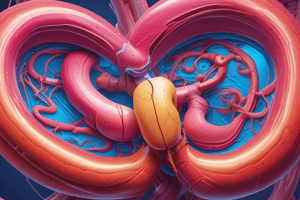Podcast
Questions and Answers
Where is urine formed?
Where is urine formed?
Urine is expelled from the body through the:
Urine is expelled from the body through the:
What are the reproductive glands located in the scrotum?
What are the reproductive glands located in the scrotum?
Which organ is not considered part of the urinary system?
Which organ is not considered part of the urinary system?
Signup and view all the answers
Which gland in the male reproductive system is partly muscular and partly glandular?
Which gland in the male reproductive system is partly muscular and partly glandular?
Signup and view all the answers
Match the following terms with their meanings:
Match the following terms with their meanings:
Signup and view all the answers
Mrs. Green is a 53-year-old woman with bilateral nephrolithiasis. What is/are the ICD-10-CM code(s)?
Mrs. Green is a 53-year-old woman with bilateral nephrolithiasis. What is/are the ICD-10-CM code(s)?
Signup and view all the answers
Mr. Jones is an 85-year-old male who has gross hematuria. What is the ICD-10-CM code for gross hematuria?
Mr. Jones is an 85-year-old male who has gross hematuria. What is the ICD-10-CM code for gross hematuria?
Signup and view all the answers
Jake is a 16-year-old male with a fractured kidney. What is the ICD-10-CM code for the fractured kidney?
Jake is a 16-year-old male with a fractured kidney. What is the ICD-10-CM code for the fractured kidney?
Signup and view all the answers
The patient is a 68-year-old male with urinary retention and enlarged prostate gland. What is/are the ICD-10-CM code(s)?
The patient is a 68-year-old male with urinary retention and enlarged prostate gland. What is/are the ICD-10-CM code(s)?
Signup and view all the answers
Study Notes
Urinary System Overview
- Urine is formed in the kidneys through renal tubules, eventually emptying into the renal pelvis, and then traveling to the bladder via the ureters.
- The urethra is the structure through which urine is expelled from the body after storage in the bladder.
Male Reproductive System
- The testes, found in the scrotum, are key reproductive glands responsible for producing sperm.
- The prostate gland is both muscular and glandular, playing an essential role in male reproductive health.
Organs in the Urinary System
- Major components of the urinary system include kidneys, ureters, bladder, and urethra.
- The spleen is not part of the urinary system; it belongs to the lymphatic system.
Key Terminology for Genitourinary System
- Important roots, prefixes, and suffixes include:
- -cele: herniation or prolapse
- cyst/o: bladder or cyst
- dys-: abnormal or difficult
- -ectomy: surgical removal
- nephr/o: kidney
- -orrhaphy: surgical repair
- -otomy: incision or cutting into
- osche/o: scrotum
Clinical Coding Examples
- For bilateral nephrolithiasis, the correct ICD-10-CM code is N20.0, which specifically identifies kidney stones.
- The ICD-10-CM code for gross hematuria, especially from a prostatic source, is R31.0.
- A fractured right kidney is coded as S37.041A, indicating it is a minor laceration with specific notes on right-sided injury and encounter status.
- Urinary retention and enlarged prostate conditions can be coded as N40.1, R33.8, highlighting both the enlarged prostate and retention aspect.
Summary of Clinical Conditions
- Nephrolithiasis refers to kidney stones, usually calcium-based but not exclusively.
- Gross hematuria indicates blood in urine and requires careful coding based on context (e.g., previous procedures like TURP).
- Accurate coding is essential for diagnosis, particularly in male patients with urinary issues associated with prostate health.
Studying That Suits You
Use AI to generate personalized quizzes and flashcards to suit your learning preferences.
Description
Test your knowledge of the urinary and male genital systems with this quiz based on Chapter 12. It includes flashcards that challenge your understanding of the formation and expulsion of urine. Enhance your grasp of these vital biological functions and terms through interactive questions.




